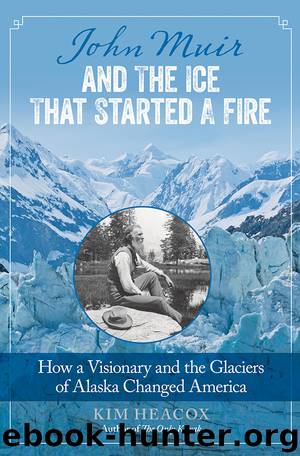John Muir and the Ice That Started a Fire: How a Visionary and the Glaciers of Alaska Changed America by Heacox Kim

Author:Heacox, Kim
Language: eng
Format: epub, azw3
Publisher: Lyons Press (R&L)
Published: 2014-03-31T16:00:00+00:00
MUIR WAS TIRED and unwell and unable to fully rest at home, busy with obligations in his scribble den. The grippe was back. The bronchial cough, too. His second Atlantic article appeared in early 1898; it dismissed Pinchot’s wise-use utilitarian argument as anything but wise. Muir was the point of the spear, “the authentic voice of conservation,” Linnie Marsh Wolfe would say, “speaking high above the babel of tongues, clearing the public mind of commercial propaganda.” His writing increased the Atlantic’s circulation “enormously,” according to his editor, and would soon help to bring about policy change in President McKinley’s Washington.
The son of immigrants, Muir was hardly ignorant about the hardscrabble life; he knew what it meant to go hungry and get his hands dirty, to sleep in winter clothes and slip on frozen boots. He acknowledged the abundance and richness of the New World, and the benefits that came from settling it, turning forests into fruit orchards and farms. But must we settle and cultivate it all? Let not selfish people subdue every acre beyond its ability to regenerate, he would say. To which Pinchot would agree.
But while Pinchot saw forests essentially as tree farms to be carefully managed, Muir did not. Forests to him were churches, some cathedrals, the best God ever made. If busy man can take one day a week and not work, and let deeper, greater values direct him, can he not take one seventh of the land and regard it differently as well, with greater honor and restraint? This “Sabbath for the Land,” as writer Scott Russell Sanders would one day call it, was Muir’s entire point. Why hurry our way into Heaven? It’s right here before us.
Slow down. Look around. Nature’s beauty is everywhere, as essential as bread.
Again, he needed mountain nourishment, and he got some with a summer jaunt through Canada, in some places picking up his old draft dodger’s trail, followed by an autumn trip into the “leafy” Appalachians of North Carolina and Tennessee with his good botany friends Charles Sargent and William Canby. The South troubled him, to see it still on its knees and hardly reconstructed, more than thirty years after the Civil War.
A letter from Louie encouraged John to stop in Washington to speak with President McKinley or with whomever he might gain an audience. “Think of the beautiful woods being left with nothing mightier than Pinchot’s little plan between them and destruction,” she pleaded. The daughter of a botanist and horticulturalist, Muir’s wife was always more fond of flowers and trees than glaciers and rocks. John ended up going to Washington but hurried home by way of Florida and Texas; he was unaware that he’d soon receive two invitations that would give him unprecedented access into America’s corridors of power: one industrial, the other political.
Download
John Muir and the Ice That Started a Fire: How a Visionary and the Glaciers of Alaska Changed America by Heacox Kim.azw3
This site does not store any files on its server. We only index and link to content provided by other sites. Please contact the content providers to delete copyright contents if any and email us, we'll remove relevant links or contents immediately.
| African Americans | Civil War |
| Colonial Period | Immigrants |
| Revolution & Founding | State & Local |
Cat's cradle by Kurt Vonnegut(15182)
Pimp by Iceberg Slim(14393)
4 3 2 1: A Novel by Paul Auster(12281)
Underground: A Human History of the Worlds Beneath Our Feet by Will Hunt(12024)
The Radium Girls by Kate Moore(11921)
Wiseguy by Nicholas Pileggi(5671)
Perfect Rhythm by Jae(5324)
American History Stories, Volume III (Yesterday's Classics) by Pratt Mara L(5256)
The Fire Next Time by James Baldwin(5248)
Paper Towns by Green John(5089)
Pale Blue Dot by Carl Sagan(4912)
A Higher Loyalty: Truth, Lies, and Leadership by James Comey(4843)
The Mayflower and the Pilgrims' New World by Nathaniel Philbrick(4423)
The Doomsday Machine by Daniel Ellsberg(4416)
Killers of the Flower Moon: The Osage Murders and the Birth of the FBI by David Grann(4385)
The Sympathizer by Viet Thanh Nguyen(4305)
Too Much and Not the Mood by Durga Chew-Bose(4272)
The Borden Murders by Sarah Miller(4247)
Sticky Fingers by Joe Hagan(4101)
